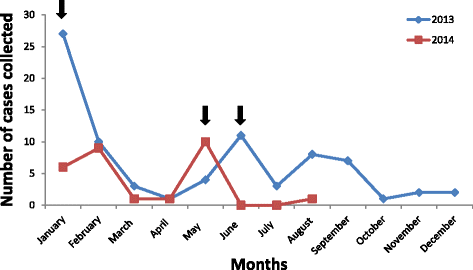Viral aetiologies of acute encephalitis in a hospital-based South Asian population
- PMID: 28438128
- PMCID: PMC5404678
- DOI: 10.1186/s12879-017-2403-z
Viral aetiologies of acute encephalitis in a hospital-based South Asian population
Abstract
Background: The aetiological spectrum of acute encephalitis shows inter- and intra-geographical variations. We aimed to identify the viruses that cause infectious encephalitis in Sri Lanka, which represents a South Asian population.
Methods: A cross-sectional study was conducted among 99 patients with encephalitis/meningoencephalitis admitted to two tertiary-care hospitals in Colombo. Cerebrospinal fluid and serum were tested for conventional and emerging encephalitogenic viruses. Specific nucleic acid amplification and antibody assays were used to identify viruses. Plaque reduction neutralization test was done to confirm the diagnosis of West Nile virus (WNV).
Results: Patients' age ranged from 1 month to 73 years (mean = 24.91; SD = 21.33) with a male:female ratio of 1.75:1. A viral aetiology was identified in only 27.3%. These included dengue virus (40.7%), Japanese encephalitis virus (25.9%), varicella zoster virus, WNV and probable Epstein Barr virus (11.1% each). None were positive for herpes simplex viruses or cytomegalovirus. Screening for bacterial aetiologies was negative for all patients. There were no distinguishable clinical or laboratory findings between the different viral aetiologies. The case fatality rate was 7%, which was higher among patients with an identified viral aetiology.
Conclusions: A viral aetiology was identified in only about a quarter of patients with encephalitis. Dengue virus accounted for the majority.
Keywords: South Asia; Sri Lanka; WNV; dengue; encephalitis; virus.
Figures
Similar articles
-
Emergence of human West Nile Virus infection in Sri Lanka.BMC Infect Dis. 2015 Jul 31;15:305. doi: 10.1186/s12879-015-1040-7. BMC Infect Dis. 2015. PMID: 26227390 Free PMC article.
-
Acute meningoencephalitis associated with echovirus 9 infection in Sri Lanka, 2009.J Med Virol. 2015 Dec;87(12):2033-9. doi: 10.1002/jmv.24267. Epub 2015 May 21. J Med Virol. 2015. PMID: 25983131
-
Detection of West Nile Virus Infection in Viral Encephalitis Cases, China.Vector Borne Zoonotic Dis. 2019 Jan;19(1):45-50. doi: 10.1089/vbz.2018.2275. Epub 2018 Jul 9. Vector Borne Zoonotic Dis. 2019. PMID: 29985780
-
High-throughput sequencing for the aetiologic identification of viral encephalitis, meningoencephalitis, and meningitis. A narrative review and clinical appraisal.Clin Microbiol Infect. 2019 Apr;25(4):422-430. doi: 10.1016/j.cmi.2018.12.022. Epub 2019 Jan 11. Clin Microbiol Infect. 2019. PMID: 30641229 Free PMC article. Review.
-
Treatment of Viral Encephalitis.Neurol Clin. 2021 Feb;39(1):197-207. doi: 10.1016/j.ncl.2020.09.011. Epub 2020 Nov 7. Neurol Clin. 2021. PMID: 33223083 Review.
Cited by
-
Effective treatment of osmotic demyelination syndrome with plasmapheresis: a case report and review of the literature.J Med Case Rep. 2021 Jan 11;15(1):6. doi: 10.1186/s13256-020-02573-9. J Med Case Rep. 2021. PMID: 33430956 Free PMC article. Review.
-
Global Landscape of Encephalitis: Key Priorities to Reduce Future Disease Burden.Clin Infect Dis. 2023 Nov 30;77(11):1552-1560. doi: 10.1093/cid/ciad417. Clin Infect Dis. 2023. PMID: 37436770 Free PMC article. Review.
-
Herpes Simplex Virus-2 Encephalitis Complicated with Multiple Cranial Neuritis and Dysautonomia.J Pediatr Neurosci. 2021 Oct-Dec;16(4):344-346. doi: 10.4103/jpn.JPN_239_20. Epub 2021 Jul 19. J Pediatr Neurosci. 2021. PMID: 36531770 Free PMC article.
-
Significance of Neuronal Autoantibodies in Comparison to Infectious Etiologies among Patients Presenting with Encephalitis in a Region with a High Prevalence of Infections.Ann Indian Acad Neurol. 2022 May-Jun;25(3):473-478. doi: 10.4103/aian.aian_280_21. Epub 2022 Mar 17. Ann Indian Acad Neurol. 2022. PMID: 35936609 Free PMC article.
-
Role of NS1 antibodies in the pathogenesis of acute secondary dengue infection.Nat Commun. 2018 Dec 7;9(1):5242. doi: 10.1038/s41467-018-07667-z. Nat Commun. 2018. PMID: 30531923 Free PMC article.
References
MeSH terms
Substances
LinkOut - more resources
Full Text Sources
Other Literature Sources


